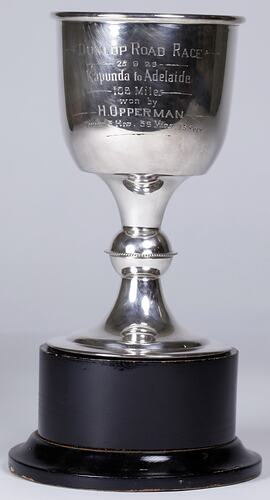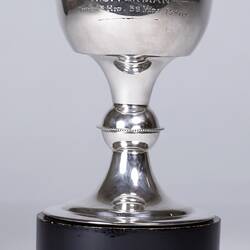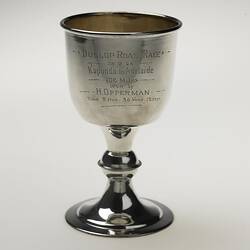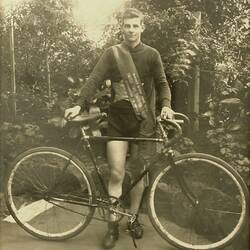Summary
This cup trophy was awarded to Hubert Opperman for winning the Dunlop Road Race from Kapunda to Adelaide, South Australia on the 25th September 1926, in a time of 5 hours, 36 minutes and 13 seconds. This was the 11th edition of the race, considered the premier cycling event for South Australia, and sponsored by the Dunlop Rubber Company. It was run over a 106 mile (170.6 km) course that made its way over ironstone, pipeclay and finally a bitumen road after Gawler, the final 25 miles of the race. The road conditions were terrible due to the rain which had been falling since the previous evening and the 42 entrants began in conditions described as "cold, wet and cheerless".
As was the case with almost all Australian road cycling races at the time, the race was conducted as a handicap, with riders given a timed headstart according to their perceived ability. The two 'limit' riders for this race began 60 minutes before Opperman and his fellow Victorian rider, J.J. Beasley, who were both on the 'scratch' mark. They had both arrived in Kapunda the previous afternoon, having ridden their bicycles from Adelaide after disembarking from the Melbourne train.
Opperman and Beasley were able to gain on the other competitors, arriving covered in mud at Tarlee (60 miles into the race). However Beasley had to stop to fix punctures, and Opperman was left to ride alone, overtaking all the other riders by Gawler (25 miles to go). By this stage the race had lost just over half the entrants to the poor weather and road conditions (wheels buried inches in muddy roads,) and mechanical failures (broken wheels, chains, punctures). Opperman continued riding solo to the finish. Spectators had to wait over 10 minutes for the next rider to cross the finish line at Enfield on the outskirts of Adelaide.
"His victory is all the more remarkable because rain had rendered the roads in parts practically impassable, but Opperman ploughed through slush, rain and wind to a victory which will be long remembered in South Australia."
At 22 years of age, Opperman had come into this race with a reputation for fine endurance performances as demonstrated with best time performances in premier race events over the previous two race seasons. This race increased his reputation and demonstrated his ability to push his well trained body and focussed mind to its limits.
Physical Description
Trophy formed from a cup and base, manufactured from electro-plated nickel silver, with gold plate inside the cup. A plaster balast appears to be inside the base, as it can be partially seen through two holes in the underside of the base.
More Information
-
Collection Names
-
Collecting Areas
-
Acquisition Information
Cultural Gifts Donation from Sir Hubert Opperman, Jun 1979
-
Acknowledgement
Donated under the Australian Government's Cultural Gifts Program by Sir Hubert Opperman.
-
Awarded To
Sir Hubert Opperman, Kapunda, South Australia, Australia, 25 Sep 1926
-
Sponsor
Dunlop Rubber Company of Australasia Ltd, Melbourne, Greater Melbourne, Victoria, Australia, 1926
-
Inscriptions
On outside of cup: '- DUNLOP ROAD RACE - / ----- 25 9 26 ---- / Kapunda to Adelaide/ - 106 Miles - / won by / - H. OPPERMAN - / Time 5 Hrs. 36 Min. 13 Secs'.
-
Classification
-
Category
-
Discipline
-
Type of item
-
Overall Dimensions
225 mm (Height), 125 mm (Outside Diameter)
-
Dimensions
160 mm (Height), 97 mm (Outside Diameter)
Measurement From Conservation. Measuring Method: Maximum dimensions
-
References
'Local riders Unlucky' Barrier Miner (Broken Hill, NSW : 1888 - 1954), Tuesday 28 Sept 1926, p. 1
-
Keywords







